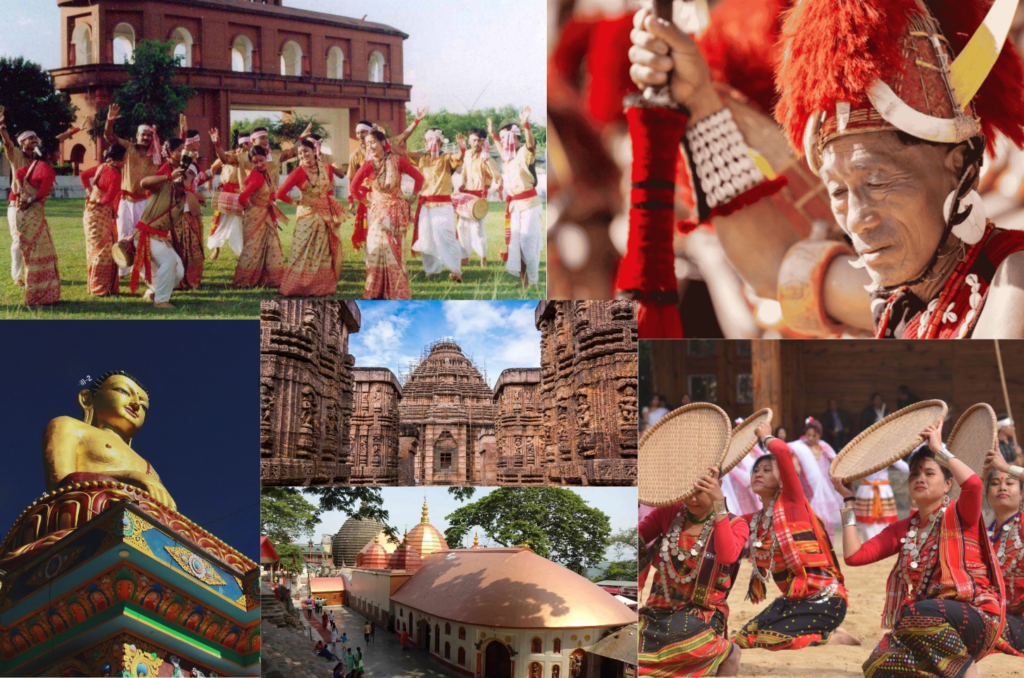
North East India is a treasure trove of vibrant cultures and ancient heritages. Known for its incredible ethnic diversity, this region is home to over 200 different tribes and a multitude of languages, customs, and traditions. The cultural diversity is reflected not only in the people but also in their art forms, festivals, attire, cuisines, and traditional practices.
This blog delves deep into the unique cultural and heritage aspects of North East India, exploring the variety and significance that make this region a must-visit for anyone keen on experiencing the rich tapestry of Indian culture.
1. Assam: The Land of Bihu and Majestic Temples
Assam is the gateway to North East India and is known for its lush tea gardens, Brahmaputra River, and silk production. However, the state’s culture and heritage are just as rich as its natural beauty. Assam is famous for its classical dance form, Sattriya, and its annual harvest festival, Bihu, which marks the Assamese New Year.
2. Nagaland: The Land of Festivals and Warrior Tribes
Nagaland, known as the “Land of Festivals,” is home to 16 major tribes, each with its distinct customs, festivals, and traditions. Nagaland’s tribal communities are known for their vibrant dance forms, colorful attire, and unique customs.
3. Manipur: The Jewel of India
Manipur, known for its classical dance form, Manipuri, is also a state steeped in tradition and history. Its unique culture blends Hinduism and traditional tribal practices, creating a diverse cultural landscape.
4. Meghalaya: The Abode of Clouds
Meghalaya is known for its picturesque landscapes, matrilineal society, and tribal cultures. The state’s Khasi, Garo, and Jaintia tribes each have their unique festivals, music, and traditions.
5. Arunachal Pradesh: The Land of the Rising Sun
Arunachal Pradesh, the easternmost state of India, is home to over 25 tribes, each with its unique customs and traditions. The state is also known for its Buddhist monasteries and ancient practices.
6. Mizoram: The Land of the Highlanders
Mizoram, with its rolling hills and scenic landscapes, is known for its lively festivals, traditional dances, and vibrant handloom industry. The Mizo people are primarily Christian, and their culture reflects a unique blend of tribal and Western influences.
7. Sikkim: The Mystic Land of Buddhism and Nature
Sikkim, the smallest state in North East India, is known for its Tibetan Buddhist heritage, stunning monasteries, and serene landscapes. The state’s unique culture is a blend of Tibetan, Nepali, and Lepcha influences.
8. Tripura: A Land of Royal Heritage
Tripura is known for its royal palaces, ancient temples, and rich tribal heritage. The state is home to several indigenous communities, including the Tripuri, Reang, and Chakma tribes.
The culture and heritage of North East India offer a mesmerizing journey into a world where ancient traditions, tribal wisdom, and vibrant festivals come alive. Each state in the region, with its distinct customs, languages, and practices, contributes to the rich cultural mosaic that defines this part of the country. From the powerful celebration of the Hornbill Festival in Nagaland to the spiritual serenity of the Tawang Monastery in Arunachal Pradesh, and the unique matrilineal society of Meghalaya, North East India is a repository of cultural treasures waiting to be explored.
Tourists who visit this region not only witness its stunning landscapes but also experience a living museum of traditions that continue to thrive amidst modernity. Whether it’s through dance, music, textiles, or festivals, the people of North East India take immense pride in their heritage, making the region a fascinating destination for anyone seeking to understand the diversity and depth of India’s cultural fabric.
A1: The Hornbill Festival, held every December, showcases the rich cultural heritage of Nagaland’s 16 major tribes. It’s a unique blend of traditional dance, music, art, and crafts, and is often referred to as the “Festival of Festivals.”
A2: In Meghalaya’s Khasi and Garo tribes, property and family lineage are passed through the mother’s side. The youngest daughter traditionally inherits the family’s assets and is responsible for caring for the parents.
A3: The Monpa tribe of Arunachal Pradesh celebrates the Losar Festival to mark the Tibetan New Year. It is significant as it blends Tibetan Buddhist customs with local Monpa traditions, including prayers, masked dances, and offering rituals.
A4: Mizoram’s traditional textiles, especially the puans (shawls), are known for their vibrant geometric patterns and bright colors, reflecting the cultural identity and status of the Mizo people.
A5: Majuli Island, the world’s largest river island, is a hub of Assamese Vaishnavite culture. It is home to numerous Sattras (Vaishnavite monasteries) that preserve traditional Sattriya dance, music, and art, making it a centre for spiritual and cultural learning.